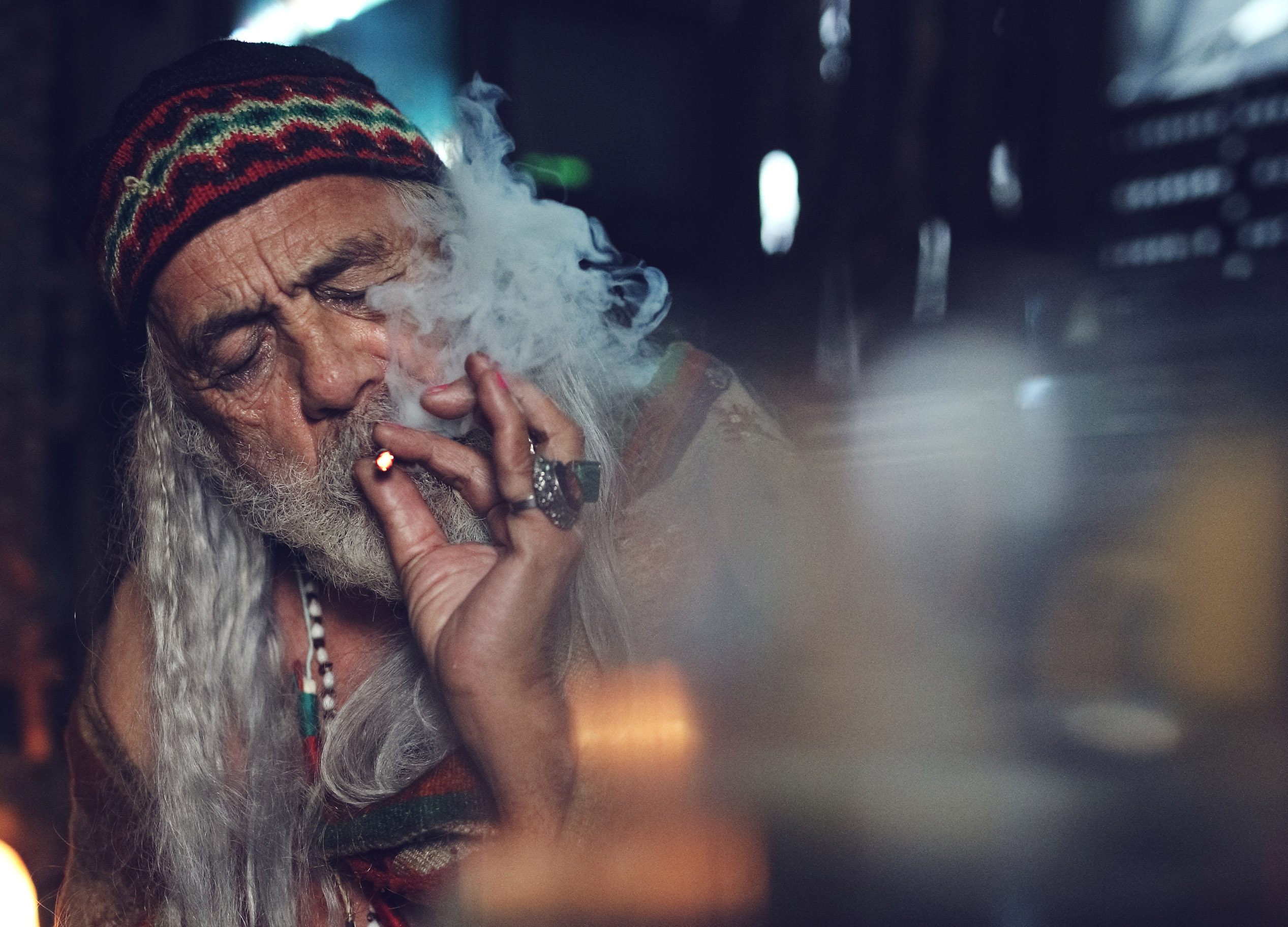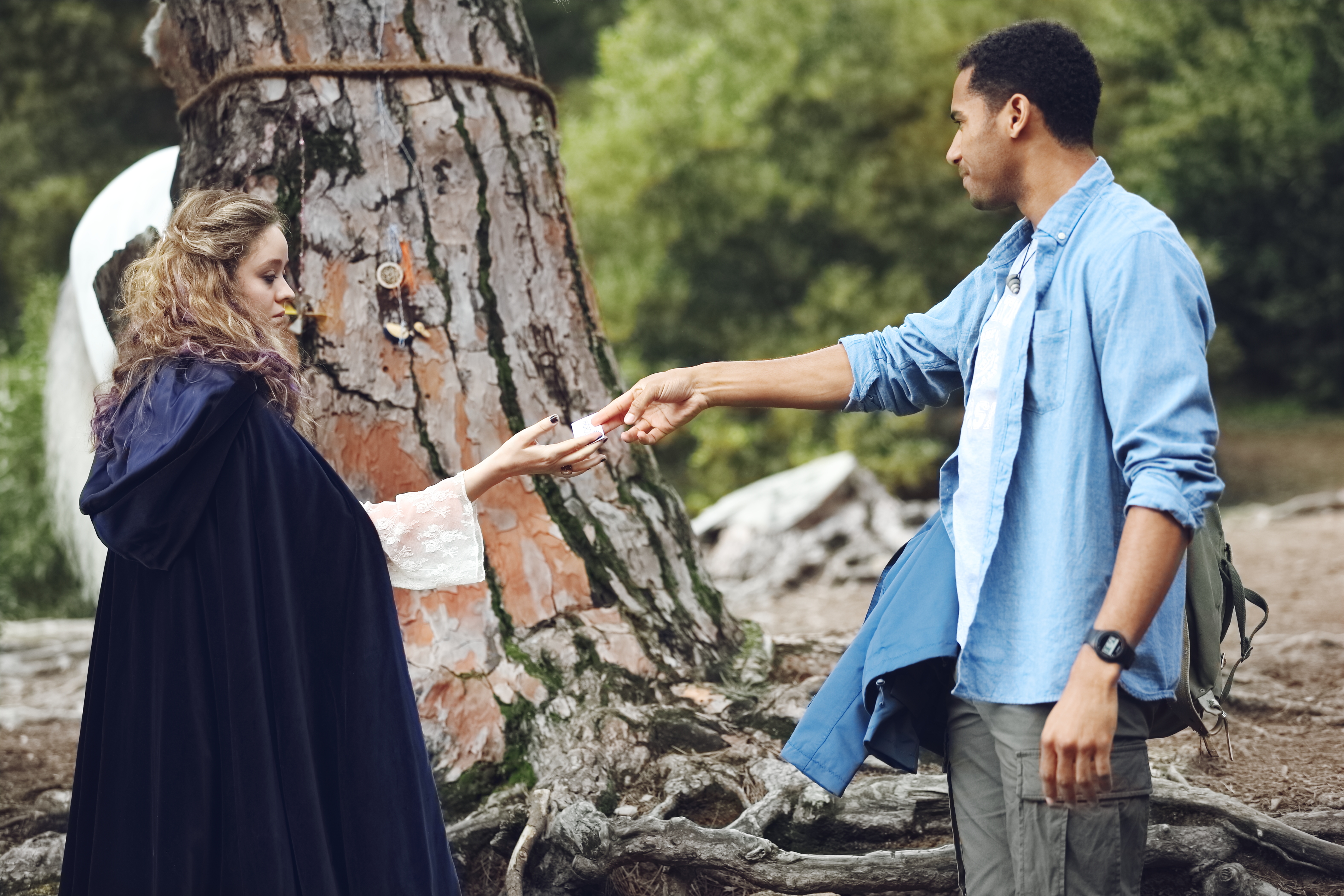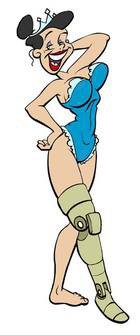
Last September at Fantastic Fest, I had the opportunity to sit down with genre film hero Richard Stanley to talk about his latest sci-fi mind trip COLOR OUT OF SPACE. Literary science fiction nerds will recognize COLOR (or COLOUR for the purists out there) as one of H.P. Lovecraft's more celebrated stories. The horror short centers on a family in rural Massachusetts who find themselves contending with an extraterrestrial force that challenges every fiber of their being. Check out my review out of the festival here.
I absolutely adored Stanley's psychedelic take on the otherworldly tale, so needless to say I was super excited to sit down and pick his brain about filmmaking, his inspirations, and letting his star go "full Cage" in COLOR OUT OF SPACE. So without further ado, here is my interview with the fabulously fascinating Richard Stanley.
Thank you so much for meeting with me today. I just saw COLOR OUT OF SPACE this morning. It's really intense.
Richard Stanley: T
totally cruel. That's a midnight movie.
Kellerman:
Kellerman:
It is a midnight movie, but there's a certain trippiness to watching it at 8:00 a.m., I have to say.
Stanley:
Stanley:
I wouldn't like to do it. I mean, I consciously made it for a late-night audience, so that it's ...
Kellerman:
Kellerman:
Yeah, so that's something that you purposely had in mind. It's a mid-nighter.
Stanley:
Stanley:
That's right. I was hoping that people would be a little drunk, a little stoned. You can almost feel beats where you're expecting the audience to yell back at the screen, or to respond to the dumb things people say. In that respect, it's definitely calibrated for a late-night audience.
Kellerman:
Kellerman:
I can see that. There's not many movies that are calibrated for an 8:00 a.m. screening, but it's festival time, so, we do what we have to do, you know?
Stanley:
Stanley:
Yeah, I grew up in that milieu of watching all day all-nighters. Midnight screenings Friday or Saturday night. That's very much what this is aimed at. COLOR's a psychedelic film. It has Tommy Chong, and it's got the freaky art. It's a difficult, it's a big ask for first thing in the morning.

Kellerman:
How do you go about adapting a story from the 1920s for a modern audience? I mean, I know Lovecraft is, sort of, timeless, but specifically, do you have any tricks, or things you avoid, or things that you have to add in? I mean, clearly, there weren't cell phones, and that sort of thing.
Stanley:
Stanley:
Yeah, on a practical level, you have to obviously, do. You spend an awful lot of time dealing with cell phones, and wondering why people don't just call an Uber, say you've got to get out of there.
Kellerman:
Kellerman:
Right, yeah.
Stanley:
Stanley:
Purely practical side, but it also feels essential, because I don't want Lovecraft to be quaint, or something which only exists in the 19th century or in the 1920s. I think with the Lovecraft cottage industry out there, the cull of consumer video games, and role-players, and things, people have started to treat him as some kind of vintage, or kind of, almost something safe. And I have my own plush cthulhu back home, but I didn't want the film to be safe. I wanted the cosmic threat to the old ones to be as terrifying, as implacable, and as impossible to deal with as ever. To present them as a clear and present danger, not just for our own generation, but for the survival of generations to come.
Kellerman:
Kellerman:
Considering the source material was written in the '20s, do you think there was any subtext, as far as ruining the planet, or is it just fully sci-fi?
Stanley:
Stanley:
I think Lovecraft has a great sense of nihilism about the future of the human race. I don't think he even necessarily thought that humans would be responsible for destroying themselves, but I don't think he had much hope for the long-term survival of humanity, I would suppose.
Kellerman:
Kellerman:
What are your favorite creature features that you draw upon whenever you're crafting something so out-there, or do you just, are you completely an original?
Stanley:
Stanley:
No, I think, probably, my favorite creature feature of all time, and it's a lame answer, but it's true, is the original King Kong. I saw it when I was four years old. My dad showed me a 16-millimeter print of the original Kong. It was the first movie I saw-
Kellerman:
Kellerman:
On 16?
Stanley:
Stanley:
Yeah, on 16-mil. It's changed my life as a four-year-old, propelled me into years of building little stop-motion models and miniatures sets, and I was fired with the idea of going to places no one'd ever been to before and bringing something back no one'd ever seen before seemed like a good aim, so-
Kellerman:
Kellerman:
Right, just find your Skull Island, and ...
Stanley:
Stanley:
Still in love with Kong. But taking a bunch of twists and turns through my life, I've spent a long time in Europe. I'm a huge fan of Dario Argento, and Lucio Fulci, and the the European horror movies from the '70s and '80s that really, threw plot logic and characterization to the side, and just went squarely towards presenting it and saying all those psychedelic set pieces, which really pushed the power of the sound and the imagery in a way that has stuck with me.
Kellerman:
So from Ray Harryhausen all the way to the Italian splatters.
Stanley:
Stanley:
And of course from Texas, Tobe Hooper. Strangely enough, Texas Chainsaw Massacre 2 is one of my favorite movies. I love the sequel. It's heretical and blasphemous to love the sequel that much, but...I got laid for the first time watchig Texas Chainsaw Massacre 2.
Kellerman:
Kellerman:
So, it has a special significance.
Stanley:
Stanley:
Yeah, I admire Tobe's way of structuring things. I like the way that it just piles one trauma on top of another trauma, on top of another trauma, and just keeps going, and keeps going, and keeps going. COLOR, again, doesn't really let up beyond a certain point. It starts real slow, but it tries to have some kind of sense of continuous lunatic escalation. In every single sequence, which I think, I've dropped it. It's probably coming from Tobe Hooper.
Kellerman:
Kellerman:
Clearly, the film has a very significant sound design element, too. Can you talk about just some of your ideas for the sound design, and any notes that you gave as far as 'chaotic', or 'ominous', or, because it seems light on the score, but heavy on the sound design. Is that true or did I ...?
Stanley:
Stanley:
Yeah, and again, it was something where we almost wanted it to, the score to evolve, kind of, organically, so that you almost don't feel score until the last reel of the movie. Where it's a very, at times, a deceptively simple score, which is just a few notes, but almost, everything's in the same key. The thing that Jack, the seven-year-old is, whistling to the thing in the well, which completes the tune, is the same themed tune that that we get much bigger at the end of the movie.
Kellerman:
Kellerman:
So, it's the same tune.

Stanley:
I like that everything was, sort of, moving to the same tune as such, but it's difficult to spot earlier on in the movie. We're also pushing, the whole time, towards things that were on the edge of the audio spectrum. The sonic spectrum exists between infrasound and between ultrasound and infrasound. Just like the visual spectrum runs between ultraviolet and infrared. In reality, we can't actually see or comprehend things that are from outside our spectrum. We are only able to experience, the closest that our human faculties can come to that, to which can sounds like either a very deep base, or a very, very high pitched whine. In terms of color, that tends to fluctuate between the infrared and the ultraviolet, which is something as close as we can get to seeing the real thing. There's an olfactory spectrum as well, which we can't approach in a movie...
Kellerman:
Kellerman:
Smell-a-vision!
Stanley:
Stanley:
Yeah! We can't have a scratch-and-sniff card that goes with the movie, where it's sort of like a combination of toast and tart, and different smells. But generally you can, sometimes you can smell things on the sweet side, as in one side of it, like the smell of roses and lilies, that what's commonly reported around Mary in apparitions. Say, when people see the Virgin Mary, they say there's a smell of sanctity. The strong sweet smell, which I think is one of the fingerprints of ultra-dimensional interference in our reality.
Kellerman:
Kellerman:
That olfactory stamp, that we can't comprehend.
Stanley:
Stanley:
Right. I don't think that the Virgin Mary necessarily smells that way, but it's a side effect of something which is messing with space-time in our normal sphere of perception. Of course, animals are have somewhat different abilities. Hence the ability of dogs and things to be able to smell earthquakes before they happen.
Kellerman:
Kellerman:
There's a lot of symbolism in the film too, but particularly triangles and also, I mean the color. And can you talk a little bit about that particular, I mean it's, it's such a beautiful color. It's like a fuchsia, pink-purple. Can you talk about the specifics of homing in on that color, and then also some of the symbolism throughout the film?
Stanley:
Stanley:
Okay. I think I've already touched on the, where we got to, how we arrived at ultraviolet and infrared, because it was really just as close as we could get to seeing something that is outside of our abilities to comprehend. But throughout the movie, there's also a supernatural witchcraft element to it, which is very played-back. And a lot of people think that doesn't quite feed into the movie, but, for me, it's the nearest way of trying to deal with the thing. The film's structured in a blatantly, pretty magical way. It tops tails with Lavinia's ritual, which starts the film, and pretty much ends the film. And it also punctuates in the middle as a second ritual when where she cuts herself with the box cutters. Which gives us, kind of, something like a ritual structure. We were very careful to try to do things right, so we have made certain that all the ritualistic elements were positive. There was lots of arguing over what rite to use at the beginning of the film. I wanted to portray Lavinia's witchcraft in a positive way. I've got a lot of witch friends, all of whom argued over how we should portray it.
Kellerman:
Kellerman:
Wiccan or Alexandrian.
Stanley:
Stanley:
Yeah, that's right. Of course if it was Alexandrian, she'd have to be Skyclad, she'd have to be naked on the riverbank, which is impossible in the present-day. We'd never be able to cast the film in a post-#metoo world having a naked teenager in a circle at the beginning was out of the question, so it couldn't be Alexandrian.
Kellerman:
Kellerman:
That's a practical reason.

Stanley:
Which pushed us towards... in reality it's a Golden Dawn ritual rather than something straight out, straight up Wiccan. The Wiccan stuff was generally more bourgeois, and it's something which is much more acceptable, I guess, amongst middle-class folk these days. I do find with most of my Wiccan friends that they're still very intimidated by the real thing.
Kellerman:
Kellerman:
Really?
Stanley:
Stanley:
That if you drag witches out into the wilds of the Peruvians, or to plunk them down in a cane plantation in Haiti, or something. The genuine supernatural can still be pretty intimidating. So, I hope the movie reflects that.
Kellerman:
Kellerman:
Can you talk about the effects a little bit? Cause it seemed like it ran the whole spectrum all the way from, I saw some stop-motion in there, I believe. And then also CG of course, and then awesome practical, gooey, slimy good stuff.
Stanley:
Stanley:
I tried to do everything practical, because I'm a big fan of it, but we had a company called User T38, which was a bunch of Spanish computer experts behind us who were there to paint over any of the mistakes, to remove rods and wires and things, and to try and improve on it. And of course, coming from Ray Harryhausen, and being a huge stop-motion fan... I think the sequence where Jack is drawing the crayon monster and the mom sees the mantis thing coming out of the well is a bit of a Harryhausen homage, and very much reflects where I was at when I was a six-year-old.
Kellerman:
Kellerman:
It's a good place to be, clearly.
Stanley:
Stanley:
Yeah.
Kellerman:
Kellerman:
Yeah. And how do you, I mean, just from a practical standpoint, as a director, how do you choose what to show and what not to show?
Stanley:
Stanley:
I mean there was an impetus to show the monster eventually, to show the color. Everyone was saying it's H.P. Lovecraft, so you shouldn't show it, but I felt that was cowardice, a de impasse perception, because Lovecraft nearly always brings the monster on, in the last page of the stories. The creatures don't stay offscreen completely in the Lovecraft stories. The characters usually die, or go mad from what they see. Certainly, the onus was on us to eventually bring the thing out of the well, and to actually show it. I think to not bring it on would have been disappointing. We were a pretty low-budget movie, so we're constrained by what we could potentially afford to show. But in that respect, I wanted to, to push the envelope as much as I possibly could on the available budget, which included trying to lift the veil a little and show the world of the Color of the very end of the movie.
Kellerman:
Kellerman:
I love the effects so much! So visceral. So great.
Stanley:
Stanley:
Yeah, and I have to hope that it's going to work a good deal better entirely at midnight. Oh, I think, I think so. First thing in the morning. It's a strange thing to wake up to. How brave you were to do that!

Kellerman:
It's not for everyone, that's for sure. But I'm not like everyone! It's almost time's up for us, but I just want to ask about working with Nicolas Cage and getting him to go "full Cage." It's the perfect role for him to show all of his stuff.
Stanley:
Stanley:
It was. He was a huge Lovecraft fan. This thing would not have happened without him. And all of that was very carefully calibrated. He went through the script weeks in advance, and highlighted different areas where he could go full Cage. We talked about where and when it was going to happen, so it never came as a surprise. He brought tremendous energy to it. Unfortunately, we cut about 50% of his big moments, because there was a concern from the backers and distributors that it was going too far. So, I have to hope that maybe one day there could be an extended cut that could include more of Nic's improvisations. But when he's cutting loose like that, once we've decided on it and it's locked in, he will repeat the mayhem, the timing and inflection perfect over and over again from every angle. He is very aware of what he's doing. And that's, although it appears insane and chaotic, it's very well reasoned on his behalf. And his very mannered and strange performance, particularly at the last part of the movie... he's drawing heavily on his dad, which is August Coppola, who's the same figure that he was some channeling in VAMPIRE'S KISS. So, to some extent, all that seems campy and out-there is actually Nic trying to come to terms with some of the things that have troubled him the most since childhood. So it's a very deliberate. Yeah, a thoughtful side to it. It's certainly not just random moments. I think Nic's got a potential horror-movie star somewhere lurking inside him. Certainly got the chops to go full Vincent Price or Boris Karloff if he gets the opportunity. And I think he did great with making Nathan unreal for me. The nascence dialogue was the cop who comes to the door and Ward at the end of the movie is, pretty much, verbatim from the Lovecraft story. I thought that he'd managed to inhabit that character enough to the point that it connected.
Kellerman:
Kellerman:
Oh, man. I want to talk to you longer!
Stanley:
Stanley:
I know. I know.
Kellerman:
Kellerman:
Thanks again for taking time out of your busy film festival schedule to talk with me about COLOR OUT OF SPACE. I can't wait until it's unleashed on the rest of the world!
Stanley:
Stanley:
Thank you.
Hopefully my chat with Richard Stanley has inspired you to go check out COLOR OUT OF SPACE when RLJE Films releases the movie in theaters on January 24 because it is definitely a big screen must-see! Go for the visually trippy storytelling, and stay for the full-Cage. You will not be disappointed.
Rebecca Elliott
aka Annette Kellerman

